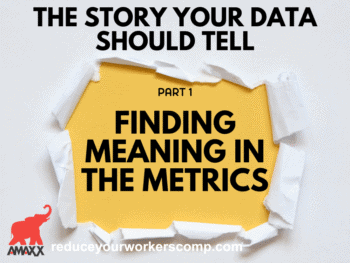A loss run is a report that outlines the details of workers compensation claims and the cost paid during a set period of time. A loss run can be created to reflect the job related accidents and claims of the most recent month, most recent quarter, most recent year or a combination of years. For most employers, the loss run comes out in the first week of the month reflecting the data as of the end of the prior month. Your loss run is produced by either your work comp insurance company or by a third party administrator (TPA) if you have a TPA handling your claims.
Loss runs can be very detailed providing extensive information on each claim, or the loss run can be very minimal listing only the claim number and the amount paid for each claim. A well-designed loss run can assist the employer to identify problem areas, develop risk management goals and control claim cost. The loss run can be customized to provide your company with the level of information you seek. It should be noted the more details you request, the longer the loss run becomes.
Most claim management information systems can sort out and provide the information you want shown on the loss run in a chart format. The employer should determine what information that want to know about their claims before asking for a loss run.
Click Link to Access Free PDF Download
The basic information that should be shown on a loss run would include:
- the claim number,
- the employee’s name,
- the date of loss,
- the status of each claim – medical only, complex medical only or indemnity
- the amount of money paid on medical benefits,
- the amount of money paid on indemnity benefits,
- the amount of money paid on claim handling expenses
- the amount of unpaid reserves for medical, indemnity and expense on each claim
If you want to make the loss run more detailed (and more complex) you can have the loss run include information on:
- the date the injury was reported to the employer (lag time)
- the date the injury was reported to the insurer or TPA (lag time)
- the date of hire (identify poor hiring practice or insufficient training)
- the state, branch and/or location within the company where the employee worked
- the equipment or tools in use at the time of the injury
- the type or nature of injury
- the body part injured
- the severity of the injury
- the employee number of the injured employee
- the employee’s NCCI job classification code number or state classification code number
- the employee’s age
- the employee’s social security number
- prior work comp claim numbers for the employee
- the litigated status of the claim
- the total amount of time each claim has been open
- the amount of money paid on each check and the party to whom the check was issued (not recommended if you have more than a few claims)
- claims with reserve changes. (Also, request “alerts” on reserve changes over $100 so you know immediately if changes occur in any claims.)
- the total number of lost days for each claim. You need to monitor lost days – it should be a flashing sign above your door!
- the length of time the employee was on the payroll before they were injured. Do new employees have more injuries? Do you need more training?
Tip: Number 27 is critical because workers comp costs are high because you have “too many claims lasting too long.” If you don’t know your lost days count you can’t control your costs effectively.
A very detailed loss run that contains all of the above information on each of your company’s claims can result in boxes of paper each month being delivered to your company, or if delivered electronically, far more pages of data than you can scan through. A poorly organized loss run is difficult to understand and does not provide you with the information you need to make proper business decisions.
Insurance companies and TPA’s can customize the reports you need, specifically for you, and have them electronically delivered to your email monthly, or weekly. The biggest mistake is to get too much information, which is overwhelming. Get the necessary information in the most succinct format possible. If you want a hard-copy report (which I prefer) you’ll probably need to beg to get it. Ask for this while you are still a prospect. 😉 The best TPA’s will happily arrange for what you need if at all possible.
To maximize the benefit of the loss run, the claim information should be sorted to provide the claim management information you need to best control your claims. Some of the possible or recommended sorts would include:
- sorting by the number of days from the accident to the reporting of the claim to the employer, then sorting by location to identify where claims are not reported to the employer timely
- sorting by the number of days from the employer’s notice to the reporting of the claim to the insurer or TPA, to identify locations who are slow reporting to the claims office
- sorting by the location then sorting by the tools or equipment to identify weak spots in your safety program (inadequate training, unsafe work conditions)
- sorting by the type of injury and the body part injured to identify either safety issues or ergonomic issues that need to be addressed
- sorting by classification code number to see which jobs are producing most of the injuries.
By using sorts of this nature on the loss run, the employer can identify the areas where the time frames can be improved and the areas where safety can be improved, both of which will lead to lower future claim cost.
FREE DOWNLOAD: “5 Critical Metrics To Measure Workers’ Comp Success”
Financial sorts of the loss run can be used to give the employer a snapshot of the level of payments and cost of claims. Some of the ways to sort the loss run financially include:
- total number of new claims in the prior month
- total number of claims closed in the prior month
- total number of all open claims at the end of the prior month
- total dollars paid on all claims in the prior month
- total dollars paid on medical benefits in the prior month
- total dollars paid on indemnity benefits in the prior month
- total dollars paid on expenses in the prior month
- total dollars paid for medical, indemnity and expense on each individual claim in the prior month
- average cost per claim
These same financial sorts can be used for the prior fiscal quarter and the prior fiscal year.
In addition to providing information on time frames, safety issues and financial issues, the properly constructed loss run can be used to determine trends in each of these areas. By comparing the results shown on the loss run with preceding months and preceding years, the employer should be able to see:
- if the overall number of claims is increasing or decreasing,
- if the cost of claims is increasing or decreasing,
- if the claim reporting program is working,
- if a location is having a disproportionate share of claims
- if the safety program is working
- if the insurance carrier or TPA is spending enough in expenses to control your claims.
A loss run for the employer is like an x-ray or an MRI for the doctor. It allows the employer to see inside of their claims program and to know what is occurring on individual claims and all of their claims. By determining what should be monitored, the loss run can be structured to provide the risk management data you need. If your loss run is not providing you with the information you need, you should be talking to your broker, TPA or insurer to restructure the loss run to fit your needs.
Author Rebecca Shafer, JD, President of Amaxx Risks Solutions, Inc. is a national expert in the field of workers compensation. She is a writer, speaker and website publisher. Her expertise is working with employers to reduce workers compensation costs, and her clients include airlines, healthcare, printing/publishing, pharmaceuticals, retail, hospitality and manufacturing.
Contact: RShafer@ReduceYourWorkersComp.com or 860-553-6604.
FREE TOOLS
WORK COMP CALCULATOR: http://www.LowerWC.com/calculator.php
MODIFIED DUTY CALCULATOR: http://www.LowerWC.com/transitional-duty-cost-calculator.php
JOIN
WC GROUP: http://www.linkedin.com/groups?homeNewMember=&gid=1922050/
SUBSCRIBE: Workers Comp Resource Center Newsletter
Do not use this information without independent verification. All state laws vary. You should consult with your insurance broker or agent about workers comp issues.
©2010 Amaxx Risk Solutions, Inc. All rights reserved under International Copyright Law. If you would like permission to reprint this material, contact Info@ReduceYourWorkersComp.com
FREE DOWNLOAD: “5 Critical Metrics To Measure Workers’ Comp Success”














